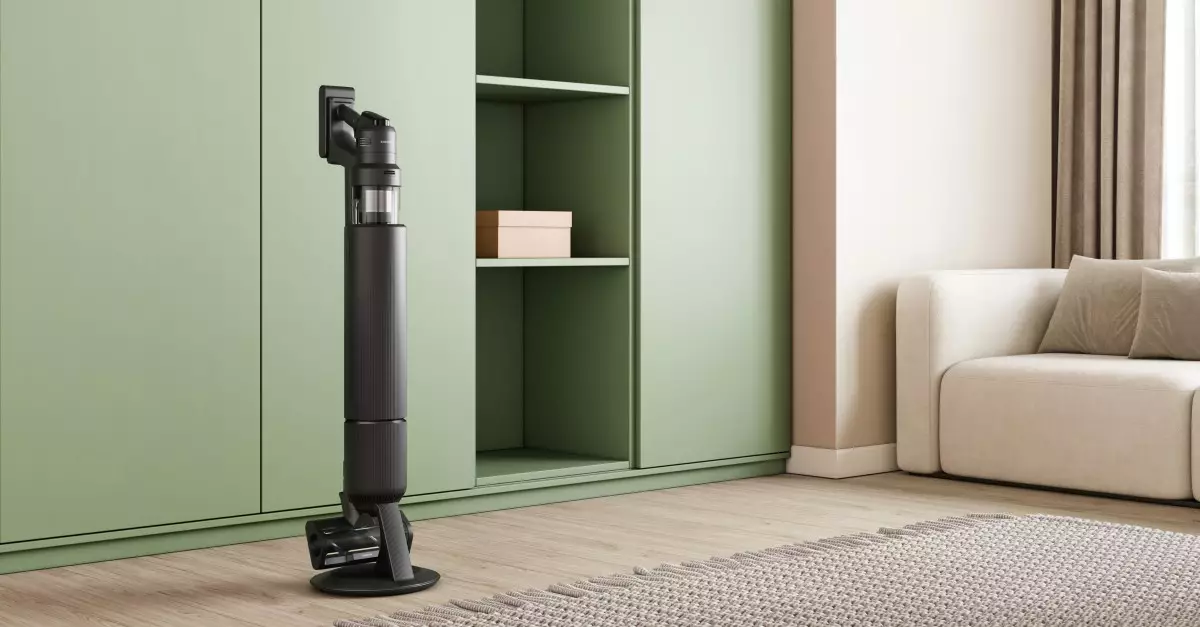As the world becomes increasingly interconnected, the role of technology in our everyday lives continues to expand. Samsung’s Bespoke AI appliances, spearheaded by innovative offerings like the Bespoke Jet AI vacuum cleaner and the Next Generation Laundry Vented Combo, exemplify this leap toward automation and convenience. However, while the functionality of these devices promises to keep you in touch with your digital world, it’s worth probing deeper into their implications for our homes and our routines.
The Bespoke Jet AI vacuum stands out with its newly integrated LCD display, enabling users to receive notifications for calls and texts—all while navigating the nuances of domestic chores. For a price of $1,099, consumers gain not only the functionality of a powerful vacuum cleaner, boasting 400AW suction and an impressive 100-minute battery life but also a portal for communication. Likewise, the Laundry Vented Combo washer and dryer, priced at $3,099, also features a touchscreen, enabling direct phone call answering during laundry cycles. But does this technology truly enhance the user experience or merely create clutter in our lives?
Integrating Work and Home Life
One might argue that Samsung’s emphasis on connectivity caters to our fast-paced lifestyles. The integration of incoming alerts amidst our daily household tasks could be seen as a straightforward solution to a common problem. Yet, the question arises: Is multitasking amidst chores genuinely productive, or does it simply add to the cacophony of distractions we face at home?
For individuals attempting to juggle their personal and professional lives, this intersection of technology and household chores could be invaluable. Picture this: you’re vacuuming, your phone buzzes, yet you cannot stop mid-task to check the message. With Samsung’s system, both a phone call and vacuuming are not just feasible but encouraged. Yet, there comes a certain irony in this advancement; one may wonder if the act of performing chores becomes secondary to managing notifications.
Samsung’s strategy positions its appliances as control hubs in the smart home ecosystem through its SmartThings platform, enabling users to manage everything from air quality to lighting. While it certainly paints a picture of a futuristic home, there is a palpable concern about whether this hyper-connected environment might lead to overwhelming dependency on technology and a decrease in mindfulness—a quality much needed during mundane tasks.
The Risks of Over-Dependence
The idea of incorporating touch screens into all facets of our home life, however appealing, raises alarms regarding technological obsolescence and reliability. These screens, while versatile, are vulnerable to damage and can potentially hinder user experience. What happens when a spill occurs, or when performance issues surface? Unlike traditional dials or knobs that have withstood the test of time, these screens may one day necessitate costly repairs or replacements—an economic consideration not to be taken lightly.
Far from simple conveniences, these integrated displays also pose concerns of privacy and advertising potential. The specter of appliances serving targeted advertisements—similar to concerns raised with many smart devices—looms large. Even if Samsung has yet to embrace this model, the very existence of such potential creates unease. Are users ultimately trading a smoother home experience for compromising their privacy?
Focusing on Functionality
Looking at the broader picture, Samsung’s innovations tap into a vision of seamless technology integration that many consumers crave. The trend of creating AI-driven home products invites prospective buyers into a realm of convenience, from smart fridges that assist with meal prep to washer-dryers that can autonomously manage detergent levels. The allure is real, but the balance between innovative design and technology fatigue must be carefully managed.
Samsung’s endeavor to provide function through connectivity speaks to a cultural shift toward automation; however, it’s crucial to question whether these advancements genuinely enhance our lifestyles or morph into mere distractions. Each appliance, rather than being a standalone tool, subtly pulls us back into the digital fray, blurring the lines between relaxation and productivity.
As we navigate this new landscape where home appliances become digitally infused, the onus is on consumers to discern which features truly add value. For a world chasing efficiency, Samsung’s bold leaps forward represent both the future of home technology and a critical dialogue about what it means to live in a world where our devices aim to keep us connected—both to our tasks and to each other.


Leave a Reply